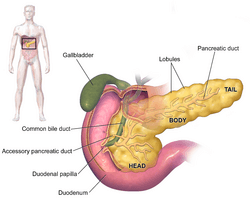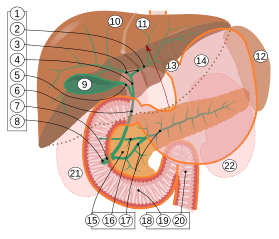Pancreas facts for kids
Quick facts for kids Pancreas |
|
|---|---|
 |
|
| Anatomy of the pancreas | |
| Latin | Pancreas |
| Artery | Inferior pancreaticoduodenal artery, anterior superior pancreaticoduodenal artery, posterior superior pancreaticoduodenal artery, splenic artery |
| Vein | Pancreaticoduodenal veins, pancreatic veins |
| Nerve | Pancreatic plexus, celiac ganglia, vagus nerve |
| Lymph | Splenic lymph nodes, celiac lymph nodes and superior mesenteric lymph nodes |
| Precursor | Pancreatic buds |
The pancreas is an important organ in your body. It makes special hormones and enzymes that help you digest your food. Think of it as a helper that breaks down carbohydrates, fats, and proteins from what you eat.
This organ is located behind your stomach, usually on the left side of your body. It's a busy organ because it works for two different body systems:
- The digestive system: It helps break down food.
- The endocrine system: It produces hormones that control things in your body.
A small but very important part of the pancreas is called the Islets of Langerhans. These "islets" (which means small islands) make hormones. They are only about 2% of the pancreas's total cells. These special cells check the levels of chemicals in your blood. Then, they make the right amount of hormones to keep everything balanced. If these islets stop working correctly, a person can get a disease called diabetes. Scientists are even trying to use islet cells from donors to help people with diabetes get better.
Pancreas Hormones
The pancreas releases several important hormones into your blood. These hormones act like messengers, telling other parts of your body what to do:
- Insulin: This hormone helps to decrease the amount of glucose (sugar) in your blood. It's like a key that lets sugar into your cells for energy.
- Glucagon: This hormone does the opposite of insulin. It increases the amount of glucose in your blood when it gets too low.
- Somatostatin: This hormone helps to control the production of both insulin and glucagon. It makes sure they don't make too much or too little.
Digestive Enzymes
Besides hormones, the pancreas also makes many different enzymes that are sent to your small intestine to help with digestion:
- Lipase: This enzyme is special because it breaks down fats in your food.
- Amylase: This enzyme helps to break down carbohydrates, like the starches in bread or pasta.
- Trypsinogen and Chymotrypsin: These enzymes work together to break down proteins into smaller pieces.
- Erepsin: This enzyme further digests smaller protein pieces, called peptones, into even tinier amino acids. Your body uses amino acids to build and repair tissues.
Pancreas Structure

9. Gallbladder, 10–11. Right and left lobes of liver. 12. Spleen.
13. Esophagus. 14. Stomach. 15. Pancreas: 16. Accessory pancreatic duct, 17. Pancreatic duct.
18. Small intestine: 19. Duodenum, 20. Jejunum
21–22. Right and left kidneys.
The front border of the liver has been lifted up (brown arrow).
The pancreas is an organ that is about 12 to 15 centimeters (about 5 to 6 inches) long in adults. It has a unique shape and is often described as looking like a fish. It's located in the upper left part of your abdomen.
The pancreas is divided into four main parts:
- The head: This widest part sits inside the curve of your duodenum, which is the first part of your small intestine.
- The neck: This is a short, narrow part that connects the head to the body.
- The body: This is the longest part of the pancreas and stretches across behind your stomach.
- The tail: This narrow end of the pancreas reaches all the way to your spleen.
Two main tubes, called ducts, run through the pancreas. These are the main pancreatic duct and a smaller accessory pancreatic duct. They join with another tube called the common bile duct. All these ducts meet near a small opening into the duodenum, allowing digestive enzymes to flow into your intestine.
The pancreas has a very good blood supply, meaning lots of blood vessels bring it nutrients and take away waste. This is important for it to work properly.
Images for kids
-
This image shows a pancreatic islet when pancreatic tissue is stained and viewed under a microscope. Parts of the digestive ("exocrine") pancreas can be seen around the islet, more darkly. These contain hazy dark purple granules of inactive digestive enzymes (zymogens).
-
A pancreatic islet that uses fluorescent antibodies to show the location of different cell types in the pancreatic islet. Antibodies against glucagon, secreted by alpha cells, show their peripheral position. Antibodies against insulin, secreted by beta cells, show the more widespread and central position that these cells tend to have.
-
The pancreas originates from the foregut, a precursor tube to part of the digestive tract, as a dorsal and ventral bud. As it develops, the ventral bud rotates to the other side and the two buds fuse together.
-
The pancreas has a role in digestion, highlighted here. Ducts in the pancreas (green) conduct digestive enzymes into the duodenum. This image also shows a pancreatic islet, part of the endocrine pancreas, which contains cells responsible for secretion of insulin and glucagon.
See also
 In Spanish: Páncreas para niños
In Spanish: Páncreas para niños














